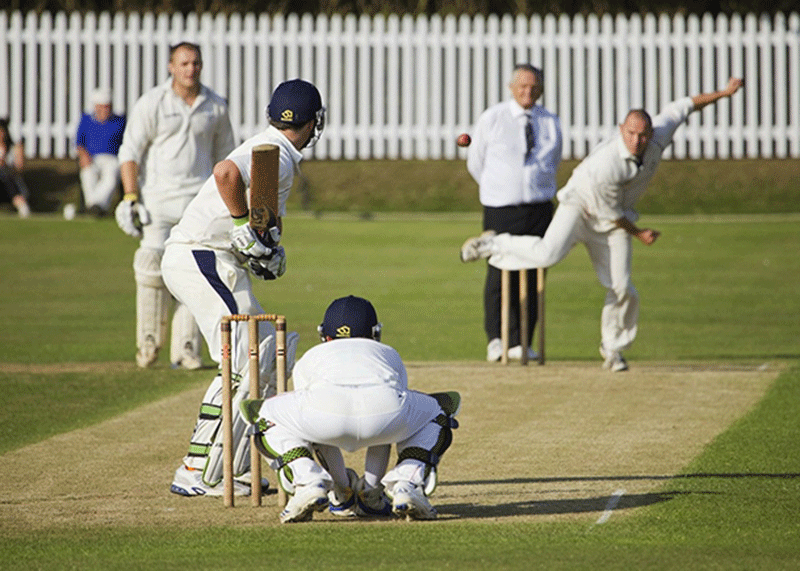Unorthodox bowling styles are outwitting cricket batters and revolutionizing the sport
A new study delves into the aerodynamics of the modern cricket bowling action and its impact on the ball’s flight path.

The physics behind bowler deliveries has puzzled sports scientists for years, but recent research is beginning to shed light on the phenomenon. (CREDIT: CC BY-SA 3.0)
In the high-stakes world of cricket, the ability to outwit batters is crucial to securing a win. Bowlers, who can send cricket balls hurtling towards their target at speeds nearing 100 miles per hour, must rely on more than just brute force. In recent years, a particular bowling technique has gained attention for its effectiveness.
This method, characterized by an almost entirely horizontal arm position during delivery, has been notably employed by Sri Lankan cricket stars like Lasith Malinga and Matheesha Pathirana. The physics behind these deliveries has puzzled sports scientists for years, but recent research is beginning to shed light on the phenomenon.
Published in the journal Physics of Fluids by AIP Publishing, a new study from scientists at Amity University Dubai in the United Arab Emirates delves into the aerodynamics of this bowling action and its impact on the ball’s flight path. Researchers, led by Faazil and colleagues, conducted experiments using a wind tunnel to explore how the pressure fields around a cricket ball change when it’s spun using a near-horizontal arm.
The findings suggest that these unorthodox bowling styles create a complex interplay of forces that make the ball particularly challenging to hit.
“The unique and unorthodox bowling styles demonstrated by cricketers have drawn significant attention, particularly emphasizing their proficiency with a new ball in the early stages of a match,” explains Kizhakkelan Sudhakaran Siddharth, one of the study’s authors. He points out that these techniques often deceive batters, allowing bowlers to remain effective throughout the entire match, across various formats.
A key factor in how a cricket ball behaves in flight is its spin, which interacts with a dimensionless quantity known as the Reynold’s number. This number takes into account the density of the air, the ball’s dimensions, its speed, and the viscosity of the fluid (in this case, air). The combination of these factors determines how much and in what way the ball deviates from its path.
To better understand these dynamics, the research team employed a wake survey rake, a device made up of multiple tubes designed to measure pressure downstream of the ball. This was used in conjunction with an advanced imaging system capable of detecting minute pressure variations in the connected manometers. Their experiments involved observing cricket balls rotating at speeds of up to 2,500 revolutions per minute in a controlled wind tunnel environment.
Related Stories
“The simultaneous traversal-imaging technique combined with the traditional manometers utilized in this study yielded remarkable precision, exceeding all expectations,” Siddharth notes. This approach allowed the team to replicate the complex and dynamic situations that occur during a cricket match within the confines of a wind tunnel, providing valuable insights into the aerodynamics at play.
One of the significant findings from the study is that as the cricket ball spins, low-pressure zones around it expand and intensify. These zones then shift and weaken as they move downstream. At higher spin rates, the low-pressure zone transitions into a persistent bilobed shape, which is a critical factor in the ball’s unpredictable trajectory.
These results support the idea that modern bowling techniques capitalize on the Magnus effect—a phenomenon where the rapid spinning of an object in flight generates forces that cause it to move in unexpected ways. The Magnus effect has long been known in physics, but its application in cricket, particularly with these novel bowling methods, highlights the sophisticated strategies employed by top-tier bowlers.
Looking ahead, Siddharth and his team are eager to further explore the physics of cricket ball dynamics. They plan to investigate how other variables, such as the wear and tear on the ball during a match, influence its aerodynamic properties.
Such research could not only enhance the understanding of cricket but also contribute to the broader field of sports physics, where the interaction between equipment and environmental factors often plays a decisive role in athletic performance.
Through this study, the complexities behind a deceptively simple-looking bowling technique have been revealed, offering a glimpse into the intricate world of cricket ball aerodynamics.
As the sport continues to evolve, so too will the understanding of the science that underpins it, ensuring that both players and fans can appreciate the subtle nuances that make cricket a game of skill, strategy, and, increasingly, science.
Note: Materials provided above by The Brighter Side of News. Content may be edited for style and length.
Like these kind of feel good stories? Get The Brighter Side of News' newsletter.
Rebecca Shavit
Science & Technology Journalist | Innovation Storyteller
Based in Los Angeles, Rebecca Shavit is a dedicated science and technology journalist who writes for The Brighter Side of News, an online publication committed to highlighting positive and transformative stories from around the world. With a passion for uncovering groundbreaking discoveries and innovations, she brings to light the scientific advancements shaping a better future. Her reporting spans a wide range of topics, from cutting-edge medical breakthroughs and artificial intelligence to green technology and space exploration. With a keen ability to translate complex concepts into engaging and accessible stories, she makes science and innovation relatable to a broad audience.



